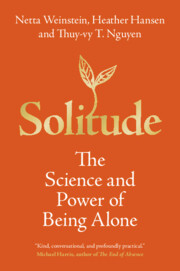Book contents
- Solitude
- Solitude
- Copyright page
- Contents
- Note to the Reader
- Introduction
- Chapter 1 Solitude Is Not Just for Hermits, Poets, and Billionaires
- Chapter 2 Everyday Solitude for Everyday People
- Chapter 3 What Makes Solitude Great?
- Chapter 4 Mapping the Benefits of Solitude
- Chapter 5 What’s Choice Got to Do with It?
- Chapter 6 Balancing Solitude with Social Time
- Chapter 7 Super/Natural Solitude
- Chapter 8 Finding Your Happy Place in Solitude
- Chapter 9 Can We Get Better at Being Alone?
- Chapter 10 Solitude across a Lifetime
- Acknowledgments
- References
- Index
Introduction
Published online by Cambridge University Press: 24 March 2024
- Solitude
- Solitude
- Copyright page
- Contents
- Note to the Reader
- Introduction
- Chapter 1 Solitude Is Not Just for Hermits, Poets, and Billionaires
- Chapter 2 Everyday Solitude for Everyday People
- Chapter 3 What Makes Solitude Great?
- Chapter 4 Mapping the Benefits of Solitude
- Chapter 5 What’s Choice Got to Do with It?
- Chapter 6 Balancing Solitude with Social Time
- Chapter 7 Super/Natural Solitude
- Chapter 8 Finding Your Happy Place in Solitude
- Chapter 9 Can We Get Better at Being Alone?
- Chapter 10 Solitude across a Lifetime
- Acknowledgments
- References
- Index
Summary
Little in mainstream society indicates that when we choose it, solitude can be wonderful, even transformative. Instead, the focus on loneliness in modern life can make us think that solitude is a disease requiring treatment, and maybe cured by avoiding solo moments altogether. Until recently, science has supported those assumptions because decades of prevailing research have focused on humans as “social animals” and the fact that fulfilling relationships are integral to well-being. By comparison, scientists have spent very little time and resources on understanding the role of solitude, and the power of positive solitude in particular, in shaping our lives. That’s why we three researchers with very different backgrounds formed our Solitude Lab and have spent several years researching what time alone means to different people around the world. In Solitude, we share those insights from thousands of people from all walks of life who helped us to redefine and reframe time alone as a chosen place, a zone of truth, sincerity, independence, and intimacy where we can best connect with our values, interests, and emotions.
Information
- Type
- Chapter
- Information
- SolitudeThe Science and Power of Being Alone, pp. 1 - 10Publisher: Cambridge University PressPrint publication year: 2024
